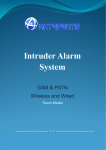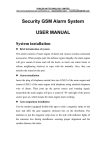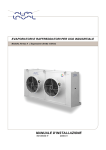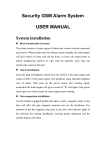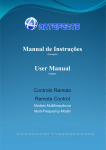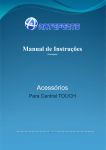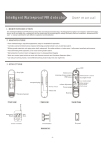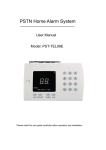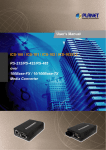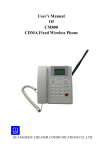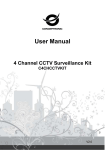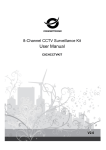Download MPEG Series Manual - Artefects by Virtualtronica
Transcript
Intruder Alarm System PSTN only Wireless Key Model 2013-01 V1.0.0 Statement This equipment must be installed and used in strict accordance with the instructions given in this user documentation. Virtualtronica cannot be held responsible for any technical or typographical errors and reserves the right to make changes to the product and manuals without prior notice. Should you require any technical assistance, please contact directly with Virtualtronica or use the site http://www.artefects.pt Notice • Keep the device away from high-temperature places, heat source and direct sunlight. • Keep away from water. If it gets wet, cut off the power immediately. • The reference range for operation humidity is below 80%RH. • The reference range for operation temperature is between -10ºC and +50ºC. • If the equipment is not working properly, please contact Virtualtronica, do not try to disassemble or modify the equipment in any way. • Check carefully the voltage of the power adaptor, don’t insert incorrect power, otherwise it will damage the device and is not covered by warranty. Technical • Working power: AC=100~230V, DC=12V 1A • Static current:<35mA (when not charging) • Built-in Li-Ion battery:3.7V 800mAH(rechargeable),Standby: around 24 hours, Full charging time: 8hours • Receiving and emitting range @ 433Mhz: about 100m(non-blocking) • Dimensions 157x100x30 mm • Weight: Central unit: 210g, Alarm current:<120mA Complete kit with box: 803g Troubleshoot • If the sensors are not working properly check the batteries and also the distance from the central • Sometimes there are other sources with wireless frequencies that can interfere with these units, like baby monitor, remote control toys, microwaves, etc. Try to find it and eliminate it or change channel. • In PSTN mode the alarm calling has priority over normal call. If on normal call when alarm occur, the line will be taken by the alarm call http://www.artefects.pt Index 1. 2. 3. PRODUCT INTRODUCTION ............................................................................................................... 4 1.1. PRODUCT SUMMARY ....................................................................................................................... 4 1.2. FEATURES ...................................................................................................................................... 4 1.3. INCLUDED IN THE BOX...................................................................................................................... 4 1.4. ZONE TYPES AND DEFINITIONS ......................................................................................................... 4 CENTRAL UNIT .................................................................................................................................. 5 2.1. IMAGES .......................................................................................................................................... 5 2.2. ALARM INSTALLATION ...................................................................................................................... 5 BASIC FUNCTIONS ............................................................................................................................ 6 3.1. SET UP DEFENSES .......................................................................................................................... 6 3.2. CANCEL DEFENSES ......................................................................................................................... 6 3.3. EMERGENCY ALARM ........................................................................................................................ 6 3.4. INTELLIGENT DEFENSES................................................................................................................... 6 4. STATUS INDICATION OF MAIN ENGINE DIGITAL TUBE ................................................................. 6 5. DISTANCE REMOTE OPERATION METHODS .................................................................................. 7 6. 5.1. CALLING TO THE CENTRAL ............................................................................................................... 7 5.2. PROCESSING METHOD AFTER RECEIVING ALARM ................................................................................ 7 FUNCTION SETTINGS........................................................................................................................ 8 6.1. WARNINGS ..................................................................................................................................... 8 6.2. OPEN AND CLOSE PASSWORD PROTECTION: ..................................................................................... 8 6.3. SET UP COMMON ALARM TELEPHONE NUMBERS # (1~5) ?...? # ....................................................... 8 6.4. SET UP EMERGENCY PHONE NUMBERS # 6 ?...? # ............................................................................. 8 6.5. DELETE TELEPHONE NUMBERS # (1~6) # ........................................................................................ 8 6.6. SET UP ALARM DELAY # 7 ?? # ......................................................................................................... 8 6.7. ALARM RINGING TIME # 9 ?? # ......................................................................................................... 9 6.8. INQUIRY ALARM DEFENCE AREA 0-9 .................................................................................................. 9 6.9. THE STATE OF SETTING UP DEFENCE AREA # 8 ?? (0~7) # ............................................................ 9 6.10. DEFENSE AREAS............................................................................................................................. 9 6.11. INPUT PASSWORD * PASSWORD * .................................................................................................... 10 6.12. LEARNING REMOTE CONTROLLER * 0 * ............................................................................................ 10 6.13. LEARNING DETECTOR * 0 1 * .......................................................... ERROR! BOOKMARK NOT DEFINED. 6.14. DESIGNATED SERIAL LEARNING DETECTOR * 8 ?? * ..................................................................... 10 6.15. DELETE ALL OF THE REMOTE CONTROLLERS * 0 2 * .......................................................................... 10 6.16. DELETE ALL OF THE DEFENSE AREA DETECTORS * 8 99 6 * ............................................................... 11 6.17. USE REMOTE CONTROLLER TO OPEN AND CLOSE THE SIREN SOUND * 2 1/0 * ..................................... 11 6.18. OPEN CRACK-PROOF FUNCTION * 3 1 * ........................................... ERROR! BOOKMARK NOT DEFINED. 6.19. CLOSE CRACK-PROOF FUNCTION * 3 0 * ......................................... ERROR! BOOKMARK NOT DEFINED. 2 http://www.artefects.pt 6.20. DELAYED TIME OF SETTING UP DEFENSE INPUTTING * 4 ?? * ............................................................. 11 6.21. OPEN THE ALARM FUNCTION WHEN TELEPHONE LINES DISCONNECT * 5 1 * ........................................ 11 6.22. CLOSE THE ALARM FUNCTION WHEN TELEPHONE LINES DISCONNECT * 5 0 * ...................................... 11 6.23. REMOTE SETUP TELEPHONE RINGING TIMES * 6 ? * .......................................................................... 11 6.24. RECOVER FACTORY SETTINGS * 8 PASSWORD * ............................................................................... 11 6.25. SET UP ALARM VOICE RECORD * 0 PASSWORD * ............................................................................... 11 6.26. PLAY AUDIO TAPE * 9 * ................................................................................................................... 11 7. INCLUDED ACCESSORIES TECHNICAL SPECIFICATIONS ......................................................... 12 7.1. W IRELESS REMOTE CONTROL ....................................................................................................... 12 7.2. W IRELESS INTELLIGENT DOOR SENSOR ......................................................................................... 12 7.2.1. Door Sensor installation ....................................................................................... 12 7.3. W IRELESS WIDE-ANGLE PIR SENSOR............................................................................................. 12 7.3.1. PIR Sensor installation ......................................................................................... 13 3 http://www.artefects.pt 1. PRODUCT INTRODUCTION 1.1. Product summary Thank you for choosing our company’s Intruder Alarm System. This alarm system combines a complete kit for intrusion alarm with a Central Unit, a magnetic sensor, a motion sensor PIR, 2 remote controls and a power supply. It is very suitable and affordable for houses, garages, shops, small to medium office building, and several other uses. You can also use other accessories like gas, flood, smoke/fire sensors or internal and external sirens, panic buttons and external keypads with this central unit. For more information regarding other accessories please go to www.artefects.pt 1.2. Features • Keypad and Blue LED display • 5 phone numbers to call on alarm • 1 phone number to call on emergency • Settings for: Arm Delay; Alarm Delay, Administrator Password; • Crack proof function – None wireless remote controller can cancel defences • Alarm on Landline disconnection • 99 wireless zones. Every zone with types of defence • 7 types of defence areas (Bypass, Common, Intelligent, Emergency, Multi-check, Delayed, Repeat Triggered) • Alarm Information Mode: PSTN Call • Learning codes for remote controls and sensors • Support Arming/disarming and monitor(voice) by calling to the alarm unit. • Arm/disarm by: Remote control, Main keypad, Voice call or optional wireless keypad 1.3. Included in the box • 1 Intrusion alarm central. Can connect by landline. Battery included • 1 Internal wired siren • 2 Remote controls to Away Arm, Home Arm, Disarm and panic. Batteries included • 1 PIR motion sensor with wall stand and battery • 1 Magnetic door sensor with duple sided tape and battery • 1 Power supply 12V 1 A • 1 Cable to connect landline • 1 User manual 1.4. Zone types and definitions Perimeter zone: Detect entering spaces like doors, windows and balconies. Motion zone: Detect inside spaces like living room, hall, bedrooms, etc. Emergency zone: Detect Emergency situations like gas leakage, fire, smoke, flood, panic button and vibrations. This zone keeps 24-hour monitoring status automatically. 4 http://www.artefects.pt 2. Central Unit 2.1. Images Front Top 2.2. Alarm Installation Insert the plug of telephone outside line into LINE2 of the main engine and connect LINE1 of the main engine with telephone using attached telephone wire of alarm. Then joint up the power source and warning signal; meanwhile the main engine will give a sound of “B” and light of the power source goes on, which means the main engine starts working. 5 http://www.artefects.pt 3. Basic Functions 3.1. Set up defences Press “ ”button on remote controller or “ARMING” button on panel and the main engine will give a sound of “B”, then the main engine enter the defence situation or delayed defence state. 3.2. Cancel defences Press “ ” button on remote controller or “DISARMING” button on panel and the main engine will give two sounds of “B”, then the indicator lamp dies out, so the main engine is in a state of no defences. 3.3. Emergency alarm Press “ ”button on remote controller or “ALARM” button on panel, main engine will enter the state of emergency alarm instantly, calling automatically and siren going off. Press“ ” button on remote controller once is silent alarm, while long press or two presses will open the siren. 3.4. Intelligent defences Press “ ” button on remote controller or “INTELLIGENT” button on panel, then main engine will enter the state of intelligent defence or delayed defence. 4. Status indication of main engine digital tube The main panel will indicate the status of the alarm with this codes: • “SF” for defence, • “CF” for no defence, • “99” for emergency alarm, • “bF” for intelligent defence. • “F1” for alarm when telephone lines disconnect, • “F3” means there is no learning defence area, 1-98 means wireless defence area, L1-L8 means wired defence area. 6 http://www.artefects.pt 5. Distance Remote operation methods 5.1. Calling to the central You can use any telephone to dial the numbers of main engine and it will put on automatically after system detecting the ring times you have been setup. When you hear the beep, input passwords (two sounds when the password is wrong, while when the wrong time is above 3, the phone will hang up automatically) and if it is correct, you can have remote control of the system. Please press # after accomplish all operations, then you can implement other operations and hang up telephone. • Press “1” to monitor the scene • Press “2” to start siren • Press “3” to stop siren • Press “4” to set up defences • Press “5” to cancel defences • Press “6” to play recorded voice • Press “#” to confirm and hang up If the password is wrong or no operations within 20 seconds, it will hang up automatically. Press “1” button once you can listen for 20 seconds 5.2. Processing method after receiving alarm In case of emergency, main machine will dial the setup telephone numbers automatically and give alarm rings based on settings. If the host’s phone is in use or not able to connect, the system will dial next alarm phone, until it is dialled and hosts confirm. It will play records after receiving alarm phone and the operation methods are similar to remote setup. 7 http://www.artefects.pt 6. Function settings All the settings can be carried out under the undefended situation with a long ring for all the proper operations while two short sounds for wrong settings. 6.1. Warnings Silent alarm # 0 0 # no alarm whistle for warning Vocal alarm # 0 1 # alarm whistles for warning 6.2. Open and Close password protection: To open password protection please press * 1 1 *, if you hear a di sound, which means set successfully. After hearing di sound, please wait about 26 seconds. The system will start password protection automatically. So if nobody can arm or disarm on the panel if no input password. After finishing, if you want to disarm or arm on the panel, you need to press *+password you set+*.For example, if i set the password is 1234, we need to press*1234* to enter into the system, and then arm or disarm. Otherwise you can't control on the panel. To close password protection Please press * 1 0 *. 6.3. Set up common alarm telephone numbers # (1~5) ?...? # Set 1-5 groups telephone number, “1-5” is the ordinal of the telephone number; “?...?”stands for telephone numbers. 6.4. Set up emergency phone numbers # 6 ?...? # The same method as above, press alarm button of the main engine and the remote alarm button will call this group number. 6.5. Delete telephone numbers # (1~6) # Delete all the selected group telephone numbers. 6.6. Set up alarm delay # 7 ?? # set up delay warning time in the delay mode zone, in seconds. Here, “??” stands for the number of seconds within the range between 0 and 99. 8 http://www.artefects.pt 6.7. Alarm ringing time # 9 ?? # The alarm ringing time without human intervention after warning, Here, the range of “??” is between 0 and 30 minutes. 6.8. Inquiry alarm defence area 0-9 Directly press 0-9 to inquiry the 10 latest alarm events and display alarm defence area (0 means the latest one). 6.9. The state of setting up defence area # 8 ?? (0~7) # Here,“??” stands for the serial number from 0 to 99. (0-7) designates the setting mode of selected defence area. 0=not use, 1=common defence area, 2=intelligent defence area, 3=emergency defence area, 4=multi-checked defence area, 5=delay-alarm defence area, 7=repeat triggered defence area. For example, press # 8 2 2 # then you can set up defence area 2 as the intelligent area. Note: When you input “99”, it means all the wireless defence area will work according to this mode. 6.10. • Defence Areas Intelligent defence area (2): After selecting an area as intelligent defence one, the defence area is not effective (it is still effective under the normal defence area), which is suitable when hosts at home, because indoor infrared alarm function is cancelled, while the gate magnetisms on the door and window are still in a state of monitoring. • Emergency defence area (3): No matter under the defended or undefended situations, once triggered it will report to the phone number immediately. This is suitable for gas reaction, smoke reaction, safe, emergency accesses and other special occasions. • Multi-checked defence area (4): Under the situation of defence or intelligent defence, if two or more detectors that set up multi-checked are all triggered within 30 seconds, the main engine will give an alarm. Therefore, based on this pattern, none of the infrared detectors will misinform the events. Note: Para funcionar neste modo deve criar 2, ou mais zonas e configurar todas neste modo. 9 http://www.artefects.pt • Delay alarm defence area (5): Este modo serve para atrasar o alarme depois da activação do sensor. Exemplo: Ao abrir a porta necessita de 10 segundos para chegar á central e desactivar a central. Este modo é ideal para o sensor magnético da porta de entrada. • Delete defence area (6): Significa • means delete selected defence areas (only for wireless defence areas). Note: when you input # 8 99 6 #, all of the wireless defence areas will be deleted. • Repeat triggered defence areas (7): When the detector is triggered once, the system will not alarm immediately. Only when it is triggered again within 5-30 seconds after the first trigger, the system will alarm. The selection of common defence area and intelligent defence area has no influence of choosing Mode 4, 5, 6, so you choose intelligent or common defence area, while selecting any one of Mode 4, 5, 6 at the same time. However, when you reselect Mode 1, 2, 3, Mode 4, 5, 7 will be cleared. 6.11. Input password * password * (The designing password is: 0000, which can be changed to another four numbers as the password) 6.12. Learning remote controller * 0 * The intelligent learning remote controller of main engine begin to count down 10 seconds When the remote or detector is triggered in 10 seconds, the main engine can distinguish automatically and give a long sound, presenting the location of remove memory, which means successful study(All of the code learning method is the same). 6.1. Delete all of the remote controllers * 0 2 * means delete all of the remote controllers. 6.2. Designated serial learning detector * 8 ?? * Connect learning detector to the designated defence area number and ?? is the defence number. For example, if you want to designate a detector to Defence Area 16, only input “* 8 16 *”. 10 http://www.artefects.pt 6.3. Delete all of the defence area detectors # 8 ?? 6 # Means delete the ?? zone of the defence area detectors (99 for all zones). 6.4. Use remote controller to open and close the siren sound * 2 1/0 * Siren sounds for opening while buzzer sounds for closing. 6.5. Delayed time of setting up defence Inputting * 4 ?? * Means the defence will begin after ?? seconds when you press the button. Here, the range of “??” is between 0 and 99. (Although it can enter defence situation immediately if you repress the defence button) 6.6. Open the alarm function when telephone lines disconnect * 5 1 * When phone lines disconnect or failure, it will give alarm rings to inform. 6.7. Close the alarm function when telephone lines disconnect * 5 0 * Means main engine will not detect telephone lines disconnection or fault. 6.8. Remote setup telephone ringing times * 6 ? * If the ring times calling local fixed-line telephone above the setting times, it will connect remote server automatically. Here, “?” is the setting ring times, while “0” means no remote setup. 6.9. Recover factory settings * 8 password * The system will recover factory settings (Clear telephone numbers, vocal alarm, alarm sounds, cancel alarm, delayed setting defence, close the function of detecting disconnected telephone lines, alarm ring time last for 5 minutes). The instruction cannot delete remote controller and defence area. 6.10. Set up alarm voice record * 0 password * It starts to record sounds at the place where 20 centimetres away from the main engine after correspond operations and the digital tube begin to countdown. It will quit automatically and the main engine gives a long sound which means the record is successful. 6.11. Play audio tape * 9 * Raise the fixed-line telephone connected with the main engine, and then you can listen to the recording contents. Press any button, it will quit the play. 11 http://www.artefects.pt 7. Included Accessories Technical Specifications 7.1. Wireless Remote Control Battery Type 27A 12V alkaline battery Emitting distance: 100m (in open area) 7.2. Wireless Intelligent Door Sensor Battery Type: 23A 12V alkaline battery Emitting distance: 100m (in open area) 7.2.1. Magnetic alarm Distance: <4cm Door Sensor installation Use the random equipped double-side tape to stick a magnetic stripe on the door and affix the gate magnetic emission box on the doorframe. Pay attention to put the magnetic strip close to the side with indicator lights of the emission box during installation, assuring proper alignment and the smaller distance the better. 7.3. Wireless wide-angle PIR Sensor Battery Type: 9V alkaline battery Emitting distance: 100m (in open area) Detecting distance: 50° 5 to 9 m 12 http://www.artefects.pt 7.3.1. PIR Sensor installation The principle of infrared detectors is to sense people’s movement through sensing infrared signals generated by bodies and the detection range is usually 5-9 meters. Infrared sensor should be installed about 2.1 meters away from ground. Aim straight at the detection ranges. Moreover, the infrared detector can be only installed in the room, without facing the sunshine, windows and other places where temperature is easy to change, because the installed location may influence the detection range and accuracy. FCC Rules - Electromagnetic Compatibility (EMC) This device compiles with FCC Rules Part 15. Operation is subject to the following two conditions. • This device may not cause harmful interference. • This device must accept any interference received, including interference that may cause 13 http://www.artefects.pt undesired operation. This equipment has been tested and found to comply with the limits for a Class B digital device, pursuant to Part 15 of the FCC Rules. These limits are designed to provide reasonable protection against harmful interference in a residential installation. This equipment generates, uses, and can radiate radio frequency energy and, if not installed and used in accordance with the instructions, may cause harmful interference to radio communications. However, there is no guarantee that interference will not occur in a partial installation. If this equipment does cause harmful interference to radio or television reception, which can be determined by turning the equipment off and on, the user is encouraged to try to correct the interference by one or more of the following measures: • Reorient or relocate the receiving antenna. • Increase the separation between the equipment and receiver. • Connect the equipment into an outlet on a circuit different from that to which the receiver is connected. • Consult the dealer or an experienced radio/TV technician for help. Shielded interface cables must be used in order to comply with emission limits. CE Rules – European regulations This digital equipmentfulfilss the requirement for radiated emission according to limit B of EN55022/1998, and the requirement for immunity according to EN50082-1/1992. Liability Virtualtronica Lda. cannot be held responsible for any technical or typographical errors and reserves the right to make changes to the product and manuals without prior notice. Virtualtronica Lda. makes no warranty of any kind regard the material contained within this document, including, but not limited to, the implied warranties of merchantability and fitness for any particular purpose. 14
















